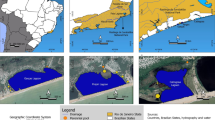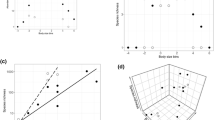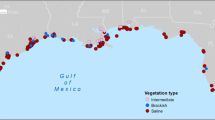Abstract
In coastal marine ecosystems, hypoxia and anoxia are emerging as growing threats whose ecological impacts are difficult to ascertain because of the frequent lack of adequate references for comparison. We applied conventional and hierarchical ensemble analyses to evaluate the weight of evidence in support of hypoxia impacts on local densities of individual and groups of demersal fish and invertebrate species in Hood Canal, WA, which is subject to seasonal hypoxia in its southern reaches. Central to our approach was a sample design and analysis scheme that was designed specifically to consider multiple alternative hypotheses regarding factors that dictate local species’ densities. We anticipated persistent effects of hypoxia (felt even when seasonal hypoxia was absent) on species densities would be most pronounced for sessile species, but that immediate effects (felt only when seasonal hypoxia was present) would dominate for mobile species. Conventional analysis provided strong evidence that densities of sessile species were persistently reduced in the hypoxic-impacted site, but did not indicate widespread immediate density responses during hypoxic events among mobile species. The absence of strong weights of evidence for hypoxia effects was partly a consequence of alternative hypotheses that better explained spatial-temporal variation in species’ densities. The hierarchical ensemble analysis improved the precision of species-specific effect sizes, and also allowed us to make inferences about the response of aggregated groups of species. The estimated mean density reductions during hypoxic events (dissolved oxygen ~2 mg/l) ranged from 73 to 98% among mobile invertebrates, benthic, and benthopelagic fishes. The large reduction in benthic and benthopelagic species suggests substantial effects of hypoxia in Hood Canal even at oxygen levels that were marginally hypoxic. Understanding the full ecological consequence of hypoxia will require a greater knowledge on the spatial extent of distributional shifts and their effects on competitive and predator–prey interactions.






Similar content being viewed by others
References
Altieri AH. 2008. Dead zones enhance key fisheries species by providing predation refuge. Ecology 89:2808–18.
Aumann CA, Eby LA, Fagan WF. 2006. How transient patches affect population dynamics: the case of hypoxia and blue crabs. Ecol Monogr 76:415–38.
Baird D, Ulanowicz R. 1989. The seasonal dynamics of the Chesapeake Bay ecosystem. Ecol Monogr 59:329–64.
Baird D, Christian RR, Peterson CH, Johnson GA. 2004. Consequences of hypoxia on estuarine ecosystem function: energy diversion from consumers to microbes. Ecol Appl 14:805–22.
Baustian MM, Craig JK, Rabalais NN. 2009. Effects of summer 2003 hypoxia on macrobenthos and Atlantic croaker foraging selectivity in the northern Gulf of Mexico. J Exp Mar Biol Ecol 381:S31–7.
Bell GW, Eggleston DB, Wolcott TG. 2003. Behavioral responses of free-ranging blue crabs to episodic hypoxia. II. Feeding. Mar Ecol Prog Ser 259:227–35.
Brandt SB, Gerken M, Hartman KJ, Demers E. 2009. Effects of hypoxia on food consumption and growth of juvenile striped bass (Morone saxatilis). J Exp Mar Biol Ecol 381:S143–9.
Breitburg D. 1992. Episodic hypoxia in Chesapeake Bay: interacting effects of recruitment, behavior, and physical disturbance. Ecol Monogr 62:525–46.
Breitburg DL, Loher T, Pacey CA, Gerstein A. 1997. Varying effects of low dissolved oxygen on trophic interactions in an estuarine food web. Ecol Monogr 67:489–507.
Breitburg D, Hondorp DW, Davias LA, Diaz RJ. 2009. Hypoxia, nitrogen, and fishereis: integrating effects across local and global landscapes. Ann Rev Mar Sci 1:329–49.
Carpenter SR, Caraco NF, Correll DL, Howarth RW, Sharpley AN, Smith VH. 1998. Nonpoint pollution of surface waters with phosphorus and nitrogen. Ecol Appl 8:559–68.
Clark JS. 2003. Uncertainty and variability in demography and population growth: a hierarchical approach. Ecology 84:1370–81.
Conley DJ, Carstensen J, Aertebjerg G, Christensen PB, Dalsgaard T, Hansen JLS, Josefson AB. 2007. Long-term changes and impacts of hypoxia in Danish coastal waters. Ecol Appl 17:S165–84.
Conley DJ, Paerl HW, Howarth RW, Boesch DF, Seitzinger SP, Havens KE, Lancelot C, Likens GE. 2009. ECOLOGY controlling eutrophication: nitrogen and phosphorus. Science 323:1014–15.
Craig JK, Crowder LB. 2005. Hypoxia-induced habitat shifts and energetic consequences in Atlantic croaker and brown shrimp on the Gulf of Mexico shelf. Mar Ecol Prog Ser 294:79–94.
Diaz RJ. 2001. Overview of hypoxia around the world. J Environ Qual 30:275–81.
Diaz RJ, Rosenberg R. 1995. Marine benthic hypoxia: a review of its ecological effects and the behavioural responses of benthic macrofauna. Oceangr Mar Biol 33:245–303.
Diaz RJ, Rosenberg R. 2008. Spreading dead zones and consequences for marine ecosystems. Science 321:926–9.
Eby LA, Crowder LB, McClellan CM, Peterson CH, Powers MJ. 2005. Habitat degradation from intermittent hypoxia: impacts on demersal fishes. Mar Ecol Prog Ser 291:249–61.
Eggleston DB, Bell GW, Amavisca AD. 2005. Interactive effects of episodic hypoxia and cannibalism on juvenile blue crab mortality. J Exp Mar Biol Ecol 325:18–26.
Fagergren D, Criss A, Christensen D. 2004. Hood canal low dissolved oxygen: preliminary assessment and corrective action plan. Puget Sound Action Team, p. 77.
Faraway JJ. 2006. Extending the linear model with R: generalized linear, mixed effects and nonparametric regression models. Boca Raton (FL): Chapman and Hall.
Gelman A, Hill J. 2007. Data analysis using regression and multlevel/hierarchical models. New York (NY): Cambridge University Press.
Gelman A, Carlin JB, Stern HS, Rubin DB. 1995. Bayesian data analysis. London: Chapman and Hall.
Harley SJ, Myers RA, Field CA. 2004. Hierarchical models improve abundance estimates: spawning biomass of hoki in Cook Strait, New Zealand. Ecol Appl 14:1479–94.
Hazen EL, Craig JK, Good CP, Crowder LB. 2009. Vertical distribution of fish biomass in hypoxic waters on the Gulf of Mexico shelf. Mar Ecol Prog Ser 375:195–207.
He JX, Bence JR. 2007. Modeling annual growth variation using a hierarchical Bayesian approach and the von Bertalanffy growth function, with application to lake trout in southern Lake Huron. Trans Am Fish Soc 136:318–30.
Kidwell DM, Lewitus AJ, Jewett EB, Brandt S, Mason DM. 2009. Ecological impacts of hypoxia on living resources. J Exp Mar Biol Ecol 381:S1–3.
Lenihan HS, Peterson CH, Byers JE, Grabowski JH, Thayer GW, Colby DR. 2001. Cascading of habitat degradation: Oyster reefs invaded by refugee fishes escaping stress. Ecol Appl 11:764–82.
Link WA, Barker RJ. 2006. Model weights and the foundations of multimodel inference. Ecology 87:2626–35.
Long WC, Seitz RD. 2008. Trophic interactions under stress: hypoxia enhances foraging in an estuarine food web. Mar Ecol Prog Ser 362:59–68.
Ludsin SA, Zhang XS, Brandt SB, Roman MR, Boicourt WC, Mason DM, Costantini M. 2009. Hypoxia-avoidance by planktivorous fish in Chesapeake Bay: implications for food web interactions and fish recruitment. J Exp Mar Biol Ecol 381:S121–31.
Nixon SW. 1995. Coastal marine eutrophication: a definition, social causes and future concerns. Ophelia 41:199–219.
Parker-Stetter JL, Horne JK. 2009. Nekton distribution and midwater hypoxia: a seasonal, diel prey refuge? Estuaries Coasts 81:13–18.
Paulsen CE 2008. Evaluating impacts of hypoxia on demersal and benthic marine communities in Hood Canal, WA. M.Sc. Thesis, University of Washington, Seattle, WA
Petersen JK, Pihl L. 1995. Responses to hypoxia of plaice, Pleuronectes platessa, and dab, Limanda limanda, in the South-East Kattegat—distribution and growth. Environ Biol Fish 43:311–21.
Pihl L. 1994. Changes in the diet of demersal fish due to eutrophication-induced hypoxia in the Kattegat, Sweden. Can J Fish Aquat Sci 51:321–36.
Pihl L, Baden SP, Diaz RJ, Schaffner LC. 1992. Hypoxia-induced structural changes in the diet of bottom-feeding fish and crustacea. Mar Biol 112:349–61.
Powers SP, Peterson CH, Christian RR, Sullivan E, Powers MJ, Bishop MJ, Buzzelli CP. 2005. Effects of eutrophication on bottom habitat and prey resources of demersal fishes. Mar Ecol Prog Ser 302:233–43.
Qian SS, Craig JK, Baustian MM, Rabalais NN. 2009. A Bayesian hierarchical modeling approach for analyzing observational data from marine ecological studies. Mar Pollut Bull 58:1916–21.
Qian SS, Cuffney TF, Alameddine I, McMahon G, Reckhow KH. 2010. On the application of multilevel modeling in environmental and ecological studies. Ecology 91:355–61.
Raftery AE. 1996. Approximate Bayes factors and accounting for model uncertainty in generalised linear models. Biom Trust 83:251–66.
Russell RE, Royle JA, Saab VA, Lehmkuhl JF, Block WM, Sauer JR. 2009. Modeling the effects of environmental disturbance on wildlife communities: avian responses to prescribed fire. Ecol Appl 19:1253–63.
Sauer JR, Link WA. 2002. Hierarchical modeling of population stability and species group attributes from survey data. Ecology 86:1743–51.
Seitz RD, Marshall LS, Hines AH, Clark KL. 2003. Effects of hypoxia on predator-prey dynamics of the blue crab Callinectes sapidus and the Baltic clam Macoma balthica in Chesapeake Bay. Mar Ecol Prog Ser 257:179–88.
Stow CA, Scavia D. 2009. Modeling hypoxia in the Chesapeake Bay: ensemble estimation using a Bayesian hierarchical model. J Mar Syst 76:244–50.
Underwood AJ. 1992. Beyond BACI—the detection of environmental impacts on populations in the real, but variable, world. J Exp Mar Biol Ecol 161:145–78.
Underwood AJ. 1994. On beyond BACI: Sampling designs that might reliably detect environmental disturbances. Ecol Appl 4:4–15.
Underwood AJ, Chapman MG. 2003. Power, precaution, Type II error and sampling design in assessment of environmental impacts. J Exp Mar Biol Ecol 296:49–70.
Vanderploeg HA, Ludsin SA, Ruberg SA, Hook TO, Pothoven SA, Brandt SB, Lang GA, Liebig JR, Cavaletto JF. 2009. Hypoxia affects spatial distributions and overlap of pelagic fish, zooplankton, and phytoplankton in Lake Erie. J Exp Mar Biol Ecol 381:S92–107.
Ward EJ. 2008. A review and comparison of four commonly used Bayesian and maximum likelihood model selection tools. Ecol Model 211:1–10.
Zhang HY, Ludsin SA, Mason DM, Adamack AT, Brandt SB, Zhang XS, Kimmel DG, Roman MR, Boicourt WC. 2009. Hypoxia-driven changes in the behavior and spatial distribution of pelagic fish and mesozooplankton in the northern Gulf of Mexico. J Exp Mar Biol Ecol 381:S80–91.
Author information
Authors and Affiliations
Corresponding author
Additional information
Author Contributions
TEE designed study, performed research, analyzed data and wrote manuscript; CEP performed research, analyzed data and contributed to the writing of the manuscript.
Rights and permissions
About this article
Cite this article
Essington, T.E., Paulsen, C.E. Quantifying Hypoxia Impacts on an Estuarine Demersal Community Using a Hierarchical Ensemble Approach. Ecosystems 13, 1035–1048 (2010). https://doi.org/10.1007/s10021-010-9372-z
Received:
Accepted:
Published:
Issue Date:
DOI: https://doi.org/10.1007/s10021-010-9372-z




